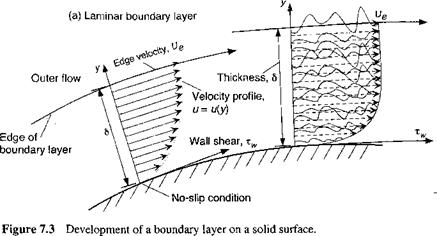Reynolds Number and Mach Number Effects
Two of the most well known parameters used in aerodynamics are the Reynolds number and the Mach number. For an airfoil, its size is described by a characteristic length based on the chord, c. When the airfoil is moving through a fluid of viscosity д, density p, and sonic velocity a, and with a speed Voo at some relative orientation to the flow, then the method of dimensional analysis shows that the force on the airfoil, F, can be written in functional form as
The combinations pV^c/p, and Voo la are called the Reynolds number (denoted by Re) and Mach number (denoted by M), respectively. Unfortunately, these parameters have both independent and interdependent influences, which complicates the understanding of the problem of finding their effects on the aerodynamic force.
7.3.1 Reynolds Number
The physical significance of the Reynolds number is that it represents the ratio of the inertial forces to the viscous forces in the fluid. This can be seen by writing the Reynolds number as
pVooC pVoociVooc) pV^c2 Inertial force
Ke = ——– = —————– = —————– = —————— . (/.Z)
M Ц’іУооС) At(Voo/c)c2 Viscous force
On the numerator, pV^c2 has units of force and so it represents an inertial force. The coefficient of viscosity, д, is the shear force per unit area per unit velocity gradient. The denominator, therefore, is a viscous force. For an ideal fluid, the Reynolds number is effectively infinite. However, when viscous forces are dominant, the Reynolds number is small in value. For helicopters the range of Reynolds numbers encountered by the rotor is significant, and Reynolds number effects on its aerodynamics are significant.
The aerodynamic characteristics of rotor airfoils must be assessed at their actual operational Reynolds numbers and Mach numbers. Figure 7.2 illustrates the operational Reynolds number and Mach number ranges typical of helicopter rotors, both at full scale and model (sub) scale. The maximum lift coefficient, C/max, can be used as one indicator of the significance of viscous effects. At the low end of the practical Reynolds number range for rotors (i. e., for chord Reynolds numbers in the range 105 < Re < 106), most airfoils have
Advancing
![]()
 |
blade
relatively low values of C;max. This is because the viscous forces are more dominant, the boundary layer is thicker, and the flow will separate more readily from the airfoil surface, all other factors being equal. In the range Re — lx 106 to 3 x 106 the greatest changes in C/max generally occur. For Re > 4 x 106 any changes in C/max are found to be more gradual. Clearly, Fig. 7.2 shows that subscale rotor models and tail rotors will fall into the range where the airfoil characteristics can be sensitive to Reynolds number. In particular, for subscale rotors the chord Reynolds numbers on the retreating blade are typically below 106 and, therefore, are more susceptible to viscous effects. This is important when assessing the performance characteristics obtained from subscale rotor tests and extrapolating the results to estimate full-scale rotor performance. Notice that the blade Reynolds numbers found on rotating-wing types of micro air vehicles (see Section 6.14) will fall well below those of even the smallest helicopter rotors, and are generally well below 105.
 |
|
It will be apparent that on the rotor blade the Reynolds number and Mach number are related by the velocity, V. For example, the Reynolds number can be written in terms of the Mach number as
This means that for a typical helicopter, with a main rotor blade chord of between 0.5 ft and 1.5 ft (0.15 m to 0.46 m), on the advancing blade at a point where the Mach number is 0.7 the Reynolds number will be as high as 0.81-2.44 x 107, and on the retreating blade at a point where the Mach number is 0.3 the Reynolds number will be only as low as 0.35-1.05 x 107.
|
(b) Turbulent boundary layer
|















